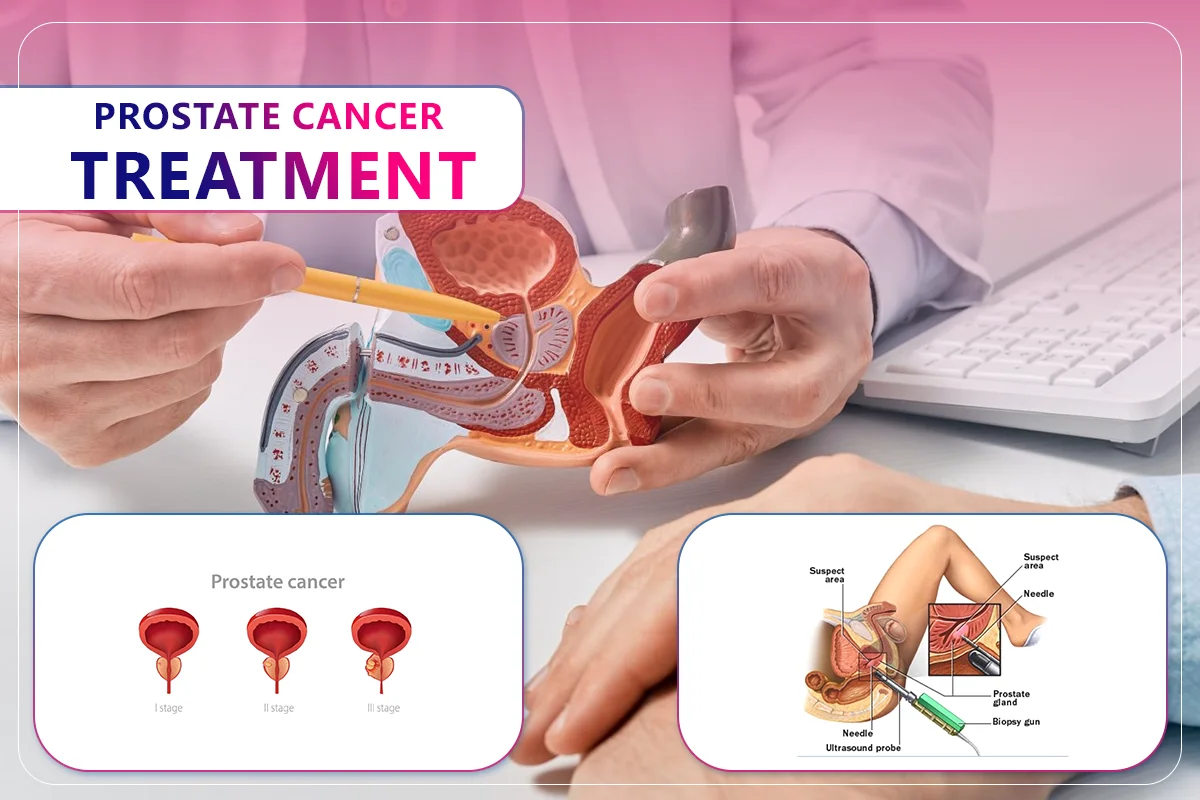Prostate cancer is one of the most common cancers that men face. It is generally fairly curable if detected early. It begins in the prostate gland, a little organ that aids in urination and reproduction.
Well, in this article, we will go through the basics of why regular check-ups are important. From basic monitoring to surgery, radiation, or more recent alternatives like immunotherapy, the course of treatment will be explained. So that you can make the greatest choices for your health when you are aware of the symptoms, phases, and available treatments.
What is Prostate Cancer?
Prostate cancer is a stage or type of cancer that usually begins in the prostate gland. It is a typical male walnut-shaped gland that produces seminal fluid, which nourishes and transports sperm. It also plays a role in controlling the urine flow.
Prostate cancer happens when cells in the prostate gland proliferate uncontrollably. Cells develop and divide in an orderly fashion normally, but in cancer, the cells continue to divide when the body doesn’t require them to. They develop into a tumour over time.
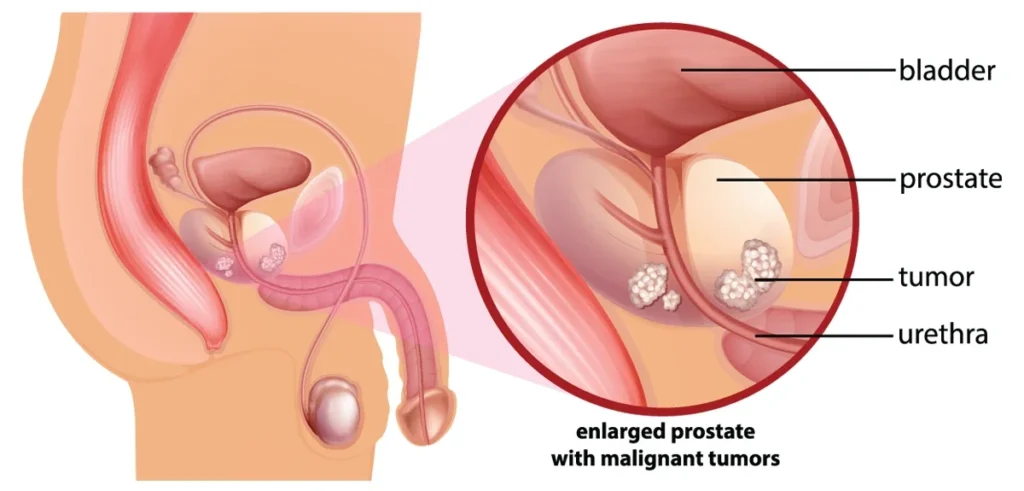
Symptoms and Diagnosis
In the early stage, prostate cancer usually doesn’t cause symptoms. It is one of the main reasons that most men don’t realise they have it until a later stage. Here are some early symptoms that people mostly face:
- Having trouble urinating or stopping
- Weak or unstable urine flow
- Often urinating, particularly at night
- Pain or a burning feeling when peeing or urinating
- Blood in semen or pee
- Hip, pelvic, or lower back pain (a symptom that cancer may have spread)
Diagnosis of prostate cancer is usually done with several tests, such as:
Prostate-Specific Antigen (PSA) Blood Test
Analyzes the blood’s PSA levels. Increased levels could be a sign of prostate cancer, but they could also be a sign of other illnesses.
Digital Rectal Exam (DRE)
To check for lumps or anomalies in the prostate, a physician gently inserts a gloved finger into the rectum.
Imaging Tests
To obtain a better image of the prostate and surrounding tissues, MRI, CT, or ultrasound studies can be performed.
Prostate Biopsy
A small sample of prostate tissue is taken and analysed under a microscope to ensure the existence of cancer cells.
Gleason Score and Grading
The abnormality of the cancer cells’ appearance is the basis for the pathologists’ score (2–10). Higher scores indicate a more aggressive cancer.
Staging Tests
Additional tests, such as bone scans or PET scans, can assist in detecting whether the cancer has progressed beyond the prostate.
Stages of Prostate Cancer
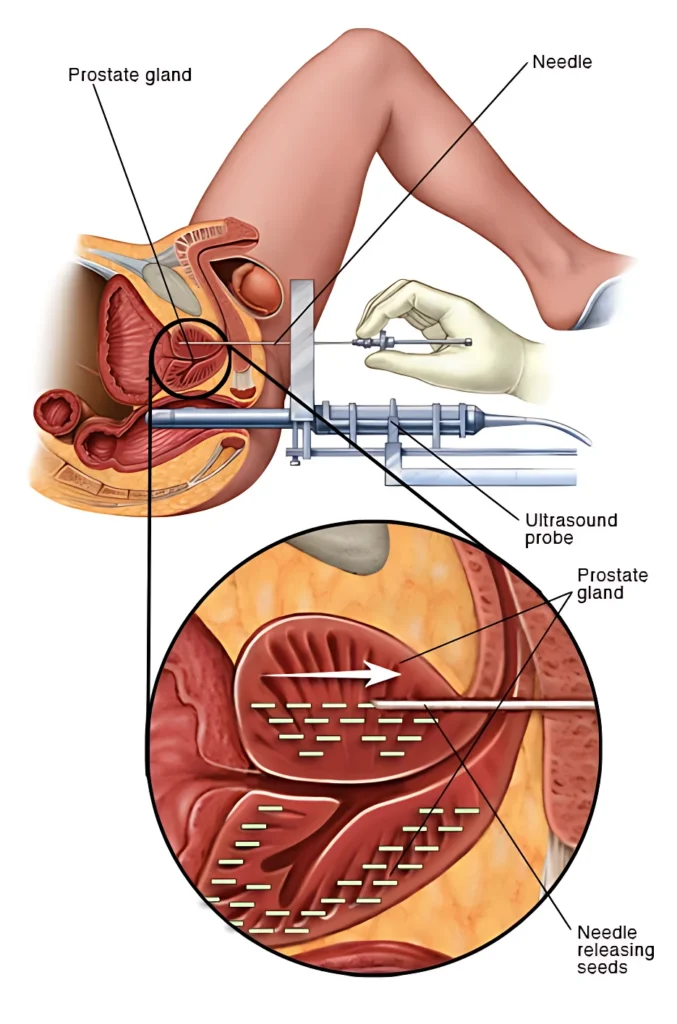
Here are the four stages of prostate cancer that the patients usually face:
Stage 1: Early/localised stage
The cancer in Stage 1 is relatively tiny and just affects the prostate. It often grows slowly, frequently exhibits no symptoms, and can be discovered by accident during standard testing. The PSA level is low, and under a microscope, the cancer cells appear less aggressive.
Stage 2: Localised but More Advanced
Even though the cancer is more advanced and may have spread to other parts of the gland, it is still limited to the prostate in Stage 2. PSA levels may be somewhat elevated, and the Gleason score indicates that the cancer may progress more quickly. Treatment at this point typically consists of radiation or surgery, occasionally in addition to hormone therapy.
Stage 3: Locally Advanced Cancer
Stage 3 prostate cancer indicates that the illness has progressed to the seminal vesicles or adjacent tissues, just outside the prostate. In most cases, cancer is more aggressive, and the PSA is high. Surgery, radiation, and hormone therapy are usually used in combination for treatment.
Stage 4: Advanced/Metastatic Cancer
By Stage 4, the cancer has progressed from the prostate to adjacent lymph nodes, bones, or even distant organs. Fatigue, weight loss, and bone discomfort are some of the symptoms of the final phase. PSA levels are typically very high, and the goal of treatment is to control the disease, reduce its progression, and enhance quality of life. Treatment options include:
- Immunotherapy
- Hormone therapy
- Chemotherapy
- Targeted therapies
Treatment Options for Prostate Cancer
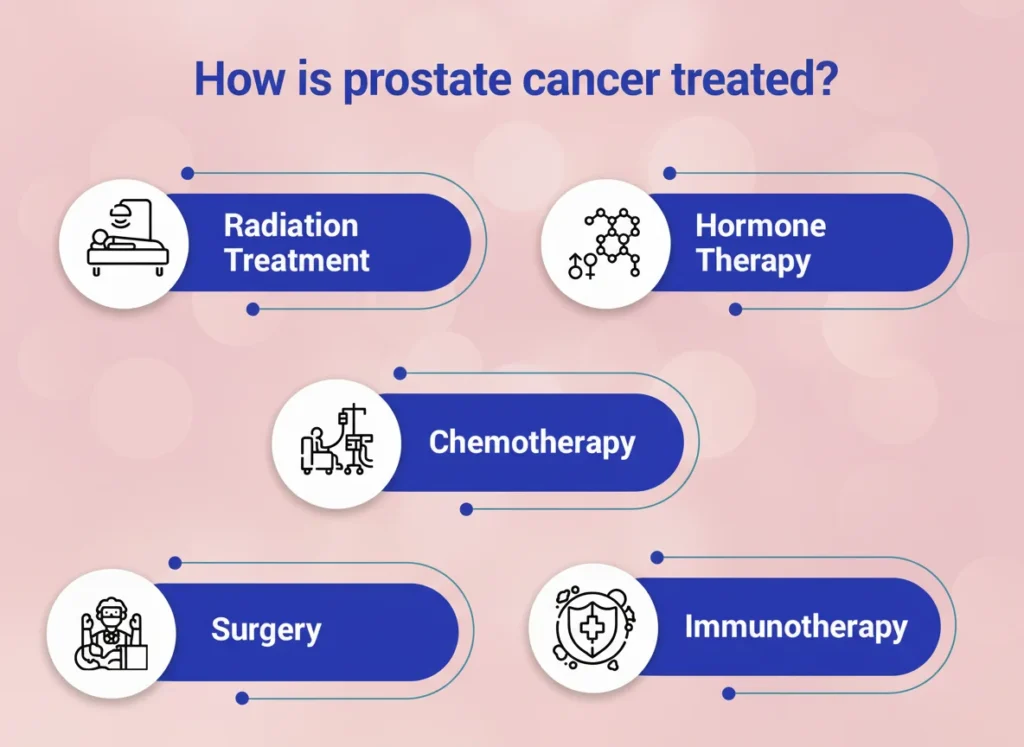
The treatment option for prostate cancer usually depends on the stage of the disease and overall health conditions. Some of the treatments include close monitoring, while some require surgery. Here are some of the standard treatments that are usually done for prostate cancer:
Active Surveillance
Active surveillance is the early stage of prostate cancer. In this stage, the cancer is usually closely monitored to see if it progresses. It is typically applied to men whose tumours are slow-growing and unlikely to cause issues.
Usually, the PSA levels are checked frequently to monitor changes. Doctors check the small samples of prostate tissue to examine if it’s becoming aggressive or not. Imaging MRI tests are also used to get a detailed view if necessary.
Surgery
Surgery is recommended for people who are healthy enough to go through it. The cancer can be removed completely through surgery. It offers a chance for a cure. Surgery provides tissue for pathological examination, which helps to determine cancer aggressiveness. The surgery contains some minor issues like bleeding, infection, or reaction to anaesthesia. It includes the follow-up PSA test to ensure cancer has not returned. Types of surgery include:
- Open Prostatectomy
- Laparoscopic Prostatectomy
- Robotic-Assisted Prostatectomy
Radiation Therapy
Radiation therapy is used to kill cancer cells or stop them from growing. It is usually used for men with localised or locally advanced prostate cancer. It can also be combined with hormone therapy for better results. It is generally known as the non-invasive option compared to surgery. It commonly maintains sexual and urinary function better than surgery, while adverse consequences are still likely to occur. Types of radiation therapy include:
- External Beam Radiation Therapy (EBRT)
- Brachytherapy (Internal Radiation)
Hormone Therapy
Hormone therapy is a treatment that reduces or blocks male hormones. By decreasing the hormone levels, the therapy can slow down the growth of the cancer. This therapy can be given in two ways. One is medications such as LHRH agonists or antagonists, which lower testosterone production. Another is a surgical procedure called orchiectomy, which removes the testicles. This therapy is typically used for advanced or metastatic prostate cancer that has spread beyond the prostate.
Chemotherapy
Chemotherapy includes powerful drugs to kill the cancer cells. This therapy is recommended when the cancer is no longer responding to hormone therapy. Chemotherapy generally works systemically, reaching cancer cells in the blood, lymph nodes, bones, and other organs.
Chemotherapy is usually given through intravenous (IV) infusion in cycles. Common chemotherapy medicines include docetaxel and cabazitaxel. Chemotherapy can slow cancer growth, but it also often comes with a lot of side effects. These side effects include hair loss, nausea, fatigue, etc.
Immunotherapy and Targeted Therapy
Immunotherapy and targeted therapy are revolutionary approaches in prostate cancer treatment. This therapy works by activating the body’s immune system to recognize and attack cancer cells. It offers a promising alternative to traditional treatments. Unlike chemotherapy, which targets fast-dividing cells, immunotherapy focuses on enhancing the body’s natural defenses, potentially reducing some of the adverse side effects associated with conventional treatments. This treatment is often recommended for men whose prostate cancer has advanced despite hormone therapy or chemotherapy, offering new hope for better outcomes.
Prostate Cancer Treatment Options for Elderly Men
Treating prostate cancer in older men depends on many factors. It mostly depends on overall health and how aggressive the cancer is. Usually, doctors recommend active surveillance to monitor regularly without immediate treatment.
If the cancer is in a serious condition and the man is healthy, then radiation and hormone therapy are recommended. Usually, surgeries are recommended to those who are fit enough for the procedure. As the goal is to maintain the quality of life, doctors personalise the treatment based on age and patient preferences.
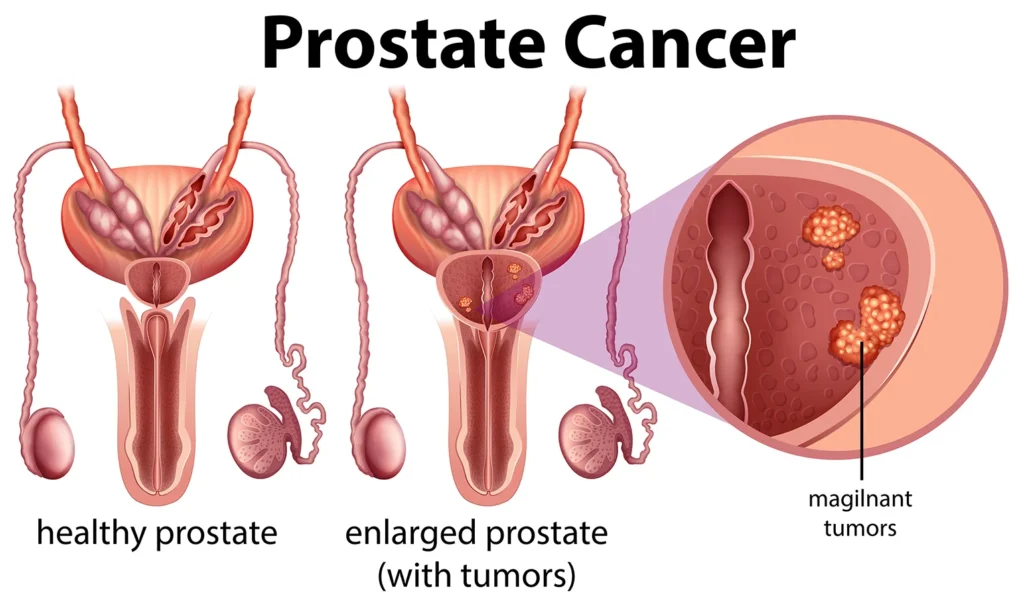
How to manage side effects of prostate cancer treatment
If you maintain the quality of life, then it gets easy to manage the side effects of prostate cancer treatment. Here are some effective ways that you can implement to manage the side effects:
- Exercises and medication can help to improve bladder control if you have a urinary problem
- If you’re having fatigue, then try light exercise, rest properly, and maintain good nutrition
- Wear light clothing, stay hydrated if you experience hot flashes and hormone changes
- The exercise doctor recommended medications to protect bones
- Maintain your emotional health by communicating with people to manage stress and anxiety
Best Treatments for Early-stage Prostate Cancer
If the condition is in the early stage, then it can be found through screening before the treatment. Advanced prostate cancer treatments can be managed with active surveillance, surgeries, or radiation therapy.
Through active surveillance, doctors closely monitor the cancer with regular PSA tests and biopsies or imaging. If it’s at low risk and slowly growing, then it’s the best option to go through active surveillance. When it’s about destroying the cancer completely, then it’s best to use the radical prostatectomy or radiation therapy.
Prostate Cancer Clinical Trials
There are many clinical trials for prostate cancer treatment. Some trials include testing new drugs, while some include exploring less invasive options. Research centres like Mayo Clinic and the US National Cancer Institute are studying new tools to slow the cancer. People who participate in early-stage prostate cancer trials look at lifestyle changes and natural compounds. If the condition seems okay, then there’s no need for aggressive treatments.
Recovery and Aftercare
After the surgery, most patients need to stay at the hospital for 2-3 days. Doctors observe them closely, then, when it’s necessary, they are asked to continue their regular life with some restrictions. Heavy lifting is strictly asked to avoid for the week after surgery. Side effects like tiredness and mild pain can take time to improve.
Some people have urine leakage after surgery, which often improves with Kegel exercises. Recovery might take time, and sexual side effects, including erection issues, are typical. This is where medications or other therapies can be helpful. Healthy eating, regular exercise, and staying away from alcohol and tobacco use all help improve quality of life and speed up recovery.
Cost of Prostate Cancer Treatment
The cost of prostate cancer treatment depends on many things. Active surveillance is the least expensive option, whereas surgery and radiation are more expensive. In South Asia, the average cost of treatment is between $2,000 to $7,000, whereas in the United States, it might range from $15,000 to $40,000. Follow-up testing, medications, and aftercare may all be part of the long-term costs as well.
Choosing the Right Oncologist and Hospital
Choosing the right hospital is an important step in prostate cancer care. Before the steps, you should research and choose the right one that fits your requirements. Here’s a complete checklist to choose the right oncologist and hospital for cancer treatment:
Choosing the Oncologist
- Look for their specialities
- Check if they have any experience with the needed treatment
- Explain your requirements clearly and answer questions openly
- Ensure that you feel supported in decision-making
- Offers access to second opinions if needed
Choosing the Hospital
- Reputation in cancer care and urology
- Offers multiple treatment options
- Has advanced diagnostic tools and modern technologies
- Uses a team-based approach
- Provides follow-up care
- Lastly, affordable within your budget
Conclusion
Treatment for prostate cancer is dependent on the disease’s stage and general health. While serious cases are treated with surgery, radiation, or medication, early discovery could allow active surveillance. Quality of life depends on recovery, follow-ups, and emotional support. Selecting a hospital and oncologist with experience guarantees the best treatment and results.
